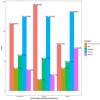Depression and Anxiety in Patients With Polycystic Ovary Syndrome: A Cross-Sectional Study in Saudi Arabia
- PMID: 38170129
- PMCID: PMC10760600
- DOI: 10.7759/cureus.51530
Depression and Anxiety in Patients With Polycystic Ovary Syndrome: A Cross-Sectional Study in Saudi Arabia
Abstract
Introduction: Polycystic ovary syndrome (PCOS) is the most common endocrine disorder in females of childbearing age. It causes irregular menstruation, infertility, acne vulgaris, androgenic alopecia, and hirsutism. It is associated with a higher risk of mental disorders. This study aimed to determine the prevalence of depression and anxiety among females with PCOS and the factors associated with these disorders.
Methods: This cross-sectional study was conducted between 15th January and 19th November 2023. We invited Saudi women to do an online survey. We sent the survey link privately, got their permission, and explained the research to ensure privacy and reliability. Females with a previous psychiatric history were excluded. Depression, Anxiety, and Stress Scale-21 Items (DASS-21) were used to assess depression, anxiety, and distress. One-way analysis of variance (ANOVA) and two-sample t-tests were used to identify determinants of depression and anxiety.
Results: About 967 females participated, of whom 474 (49%) were married, and 358 (37%) had a healthy weight. About 367 (37.9%) of participants were diagnosed with PCOS, and it was associated with age (26-35 years), divorce, and family history of PCOS (p < 0.05). About 112 (30.5%) of PCOS patients experienced extremely severe depression, and 144 (39.2%) had extreme anxiety. People in the age range of 15-25 years had a higher risk of depression and stress (p < 0.05). Divorced participants faced a higher risk of depression, anxiety, and stress than singles (p < 0.05). Those advised on diet and healthy lifestyles exhibited a higher risk of depression, anxiety, and stress than those who were not (p < 0.05). Additionally, being overweight was associated with a higher risk of depression (p < 0.05).
Conclusion: The prevalence of PCOS was found to be 37.9% in our study, which may seem higher compared to the existing literature on PCOS. It is associated with being in the age group of 26-35 years, being divorced, and having a positive family history. Almost two-thirds of females with PCOS had depression, anxiety, and stress. Factors associated with the three disorders include divorce and management with diet and lifestyle modifications. Depression and stress were associated with young age. High body mass index (BMI) was associated with depression.
Keywords: anxiety; depression; middle east; polycystic ovary syndrome; stress.
Copyright © 2024, Alnaeem et al.
Conflict of interest statement
The authors have declared that no competing interests exist.
Figures
Similar articles
-
Risk of psychological burden in polycystic ovary syndrome: A case control study in Riyadh, Saudi Arabia.J Affect Disord. 2020 Sep 1;274:205-209. doi: 10.1016/j.jad.2020.05.086. Epub 2020 May 22. J Affect Disord. 2020. PMID: 32469805
-
Role of polycystic ovarian syndrome in developing psychological burden in Saudi Arabian females: A case control study.Front Public Health. 2022 Nov 24;10:999813. doi: 10.3389/fpubh.2022.999813. eCollection 2022. Front Public Health. 2022. PMID: 36504947 Free PMC article.
-
Depression and anxiety in women with polycystic ovarian syndrome: a literature survey.Int J Adolesc Med Health. 2021 Aug 23;33(6):367-373. doi: 10.1515/ijamh-2021-0092. Int J Adolesc Med Health. 2021. PMID: 34420269 Review.
-
Prevalence of Anxiety and Depression Among Women With Polycystic Ovarian Syndrome: A Cross-Sectional Study From a Tertiary Care Hospital of Islamabad, Pakistan.Cureus. 2024 Jan 19;16(1):e52540. doi: 10.7759/cureus.52540. eCollection 2024 Jan. Cureus. 2024. PMID: 38371069 Free PMC article.
-
Direct economic burden of mental health disorders associated with polycystic ovary syndrome: Systematic review and meta-analysis.Elife. 2023 Aug 3;12:e85338. doi: 10.7554/eLife.85338. Elife. 2023. PMID: 37534878 Free PMC article.
Cited by
-
Prevalence of depression among women with polycystic ovary syndrome in mainland China: a systematic review and meta-analysis.BMC Psychiatry. 2024 Dec 18;24(1):920. doi: 10.1186/s12888-024-06378-8. BMC Psychiatry. 2024. PMID: 39696087 Free PMC article.
-
Polycystic Ovary Syndrome: A Comprehensive Exploration of Diagnosis Experience in Saudi Women.J Clin Med. 2024 Sep 7;13(17):5305. doi: 10.3390/jcm13175305. J Clin Med. 2024. PMID: 39274518 Free PMC article.
-
The prevalence and risk of anxiety and depression in polycystic ovary syndrome: an overview of systematic reviews with meta-analysis.Arch Womens Ment Health. 2025 Jun;28(3):475-489. doi: 10.1007/s00737-024-01526-1. Epub 2024 Oct 25. Arch Womens Ment Health. 2025. PMID: 39453529
References
-
- Recommendations from the 2023 international evidence-based guideline for the assessment and management of polycystic ovary syndrome. Teede HJ, Tay CT, Laven JJ, et al. https://doi.org/10.1093/ejendo/lvad096 Eur J Endocrinol. 2023;189:0–64. - PubMed
-
- Metabolic syndrome in polycystic ovary syndrome: a systematic review, meta-analysis and meta-regression. Lim SS, Kakoly NS, Tan JW, et al. https://pubmed.ncbi.nlm.nih.gov/30339316/ Obes Rev. 2019;20:339–352. - PubMed
LinkOut - more resources
Full Text Sources


